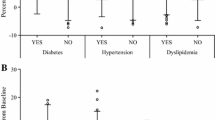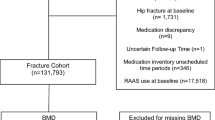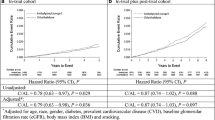Abstract
To study the risk of developing type 1 (T1D) or type 2 (T2D) diabetes among users of drugs against osteoporosis compared to nonusers. Nationwide cohort study in Denmark with all users of drugs against osteoporosis (n = 103,562) as exposed and three age- and sex-matched nondiabetic control subjects (n = 310,683) randomly selected from the background population. The main outcome variable was an incident diagnosis of diabetes after the baseline date. Among users of alendronate, etidronate, and raloxifene, no change in the risk of T1D was observed. However, the risk of developing T2D was reduced with all three drugs (alendronate: hazard ratio [HR] = 0.71, 95% confidence interval [CI] 0.59–0.85, etidronate: HR = 0.77, 95% CI 0.69–0.86, raloxifene: HR = 0.46, 95% CI 0.25–0.87). For alendronate, a dose-dependent risk reduction was observed (≥1 defined daily dose (DDD) per day: HR = 0.22, 95% CI 0.12–0.41, P for trend <0.01), while this was not the case for etidronate and raloxifene. Antiresorptive drugs do not seem associated with an increased risk of diabetes, but they may perhaps provide a protective effect related to the suppression of bone turnover. However, further studies are needed.

Similar content being viewed by others
References
Lee NK, Sowa H, Hinoi E, Ferron M, Ahn JD, Confavreux C, Dacquin R, Mee PJ, McKee MD, Jung DY, Zhang Z, Kim JK, Mauvais-Jarvis F, Ducy P, Karsenty G (2007) Endocrine regulation of energy metabolism by the skeleton. Cell 130:456–469
Ferron M, Hinoi E, Karsenty G, Ducy P (2008) Osteocalcin differentially regulates beta cell and adipocyte gene expression and affects the development of metabolic diseases in wild-type mice. Proc Natl Acad Sci USA 105:5266–5270
Confavreux CB, Levine RL, Karsenty G (2009) A paradigm of integrative physiology, the crosstalk between bone and energy metabolisms. Mol Cell Endocrinol 310:21–29
Glajchen N, Epstein S, Ismail F, Thomas S, Fallon M, Chakrabarti S (1988) Bone mineral metabolism in experimental diabetes mellitus: osteocalcin as a measure of bone remodeling. Endocrinology 123:290–295
Adami S, Passeri M, Ortolani S, Broggini M, Carratelli L, Caruso I, Gandolini G, Gnessi L, Laurenzi M, Lombardi A, Norbiato G, Pryor-Tillotson S, Reda C, Romanini L, Subrizi D, Wei L, Yates AJ (1995) Effects of oral alendronate and intranasal salmon calcitonin on bone mass and biochemical markers of bone turnover in postmenopausal women with osteoporosis. Bone 17:383–390
Meunier PJ, Confavreux E, Tupinon I, Hardouin C, Delmas PD, Balena R (1997) Prevention of early postmenopausal bone loss with cyclical etidronate therapy (a double-blind, placebo-controlled study and 1-year follow-up). J Clin Endocrinol Metab 82:2784–2791
Bjarnason NH, Sarkar S, Duong T, Mitlak B, Delmas PD, Christiansen C (2001) Six and twelve month changes in bone turnover are related to reduction in vertebral fracture risk during 3 years of raloxifene treatment in postmenopausal osteoporosis. Osteoporos Int 12:922–930
Gulhan I, Bilgili S, Gunaydin R, Gulhan S, Posaci C (2008) The effect of strontium ranelate on serum insulin like growth factor-1 and leptin levels in osteoporotic post-menopausal women: a prospective study. Arch Gynecol Obstet 278:437–441
Kostenuik PJ, Smith SY, Jolette J, Schroeder J, Pyrah I, Ominsky MS (2011) Decreased bone remodeling and porosity are associated with improved bone strength in ovariectomized cynomolgus monkeys treated with denosumab, a fully human RANKL antibody. Bone 49:151–161
Maugeri D, Panebianco P, Rosso D, Calanna A, Speciale S, Santangelo A, Rizza I, Motta M, Lentini A, Malaguarnera M (2002) Alendronate reduces the daily consumption of insulin (DCI) in patients with senile type I diabetes and osteoporosis. Arch Gerontol Geriatr 34:117–122
Kristensen J, Sandbaek A, Lassen J, Bro F, Lauritzen T (2001) Use and validation of public data files for identification of the diabetic population in a Danish county. Dan Med Bull 48:33–37
Andersen T, Madsen M, Jørgensen J, Mellemkjær L, Olsen J (1999) The Danish National Hospital Register. Dan Med Bull 46:263–268
Mosbech J, Jørgensen J, Madsen M, Rostgaard K, Thornberg K, Poulsen T (1995) The Danish National Patient Register: evaluation of data quality. Ugeskr Laeger 157:3741–3745
Lévesque LE, Hanley JA, Kezouh A, Suissa S (2010) Problem of immortal time bias in cohort studies: example using statins for preventing progression of diabetes. BMJ 340:b5087
Fleisch H (ed) (1995) Bisphosphonates in bone disease: from the laboratory to the patient. Taylor & Francis, London
Acknowledgments
The obtainment of data was supported by an unrestricted grant from the Dandy Foundation and Servier Denmark. The sponsors had no role in the preparation of the article.
Author information
Authors and Affiliations
Corresponding author
Additional information
The authors have stated that they have no conflict of interest.
Rights and permissions
About this article
Cite this article
Vestergaard, P. Risk of Newly Diagnosed Type 2 Diabetes Is Reduced in Users of Alendronate. Calcif Tissue Int 89, 265–270 (2011). https://doi.org/10.1007/s00223-011-9515-z
Received:
Accepted:
Published:
Issue Date:
DOI: https://doi.org/10.1007/s00223-011-9515-z




